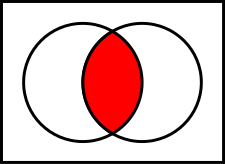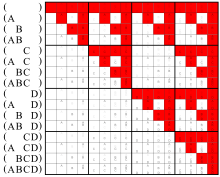Logical conjunction
| AND | |
|---|---|
 | |
| Definition | |
| Truth table | |
| Logic gate |
|
| Normal forms | |
| Disjunctive | |
| Conjunctive | |
| Zhegalkin polynomial | |
| Post's lattices | |
| 0-preserving | yes |
| 1-preserving | yes |
| Monotone | no |
| Affine | no |
| Self-dual | yes |

In logic, mathematics and linguistics, And (∧) is the truth-functional operator of logical conjunction; the and of a set of operands is true if and only if all of its operands are true. The logical connective that represents this operator is typically written as ∧ or ⋅ .
is true only if is true and is true.
An operand of a conjunction is a conjunct.
The term "logical conjunction" is also used for the greatest lower bound in lattice theory.
Related concepts in other fields are:
- In natural language, the coordinating conjunction "and".
- In programming languages, the short-circuit and control structure.
- In set theory, intersection.
- In predicate logic, universal quantification.
Notation
And is usually denoted by an infix operator: in mathematics and logic, it is denoted by ∧ , & or × ; in electronics, ⋅ ; and in programming languages, &, &&, or and. In Jan Łukasiewicz's prefix notation for logic, the operator is K, for Polish koniunkcja.[1]
Definition
Logical conjunction is an operation on two logical values, typically the values of two propositions, that produces a value of true if and only if both of its operands are true.
The conjunctive identity is 1, which is to say that AND-ing an expression with 1 will never change the value of the expression. In keeping with the concept of vacuous truth, when conjunction is defined as an operator or function of arbitrary arity, the empty conjunction (AND-ing over an empty set of operands) is often defined as having the result 1.
Truth table

The truth table of :
| T | T | T |
| T | F | F |
| F | T | F |
| F | F | F |
Defined by other operators
In systems where logical conjunction is not a primitive, it may be defined as[2]
Introduction and elimination rules
As a rule of inference, conjunction Introduction is a classically valid, simple argument form. The argument form has two premises, A and B. Intuitively, it permits the inference of their conjunction.
- A,
- B.
- Therefore, A and B.
or in logical operator notation:
Here is an example of an argument that fits the form conjunction introduction:
- Bob likes apples.
- Bob likes oranges.
- Therefore, Bob likes apples and oranges.
Conjunction elimination is another classically valid, simple argument form. Intuitively, it permits the inference from any conjunction of either element of that conjunction.
- A and B.
- Therefore, A.
...or alternately,
- A and B.
- Therefore, B.
In logical operator notation:
...or alternately,
Properties
commutativity: yes
associativity: yes
 |
 |
 |
 |
 |
distributivity: with various operations, especially with or
 |
 |
 |
 |
 |
| others | ||||||||||||||||||||||||||||||||||||||||||||||||||||||
|---|---|---|---|---|---|---|---|---|---|---|---|---|---|---|---|---|---|---|---|---|---|---|---|---|---|---|---|---|---|---|---|---|---|---|---|---|---|---|---|---|---|---|---|---|---|---|---|---|---|---|---|---|---|---|
|
with exclusive or:
with material nonimplication:
with itself:
|
idempotency: yes
monotonicity: yes
 |
 |
 |
 |
truth-preserving: yes
When all inputs are true, the output is true.
| (to be tested) |
falsehood-preserving: yes
When all inputs are false, the output is false.
| (to be tested) |
Walsh spectrum: (1,-1,-1,1)
Nonlinearity: 1 (the function is bent)
If using binary values for true (1) and false (0), then logical conjunction works exactly like normal arithmetic multiplication.
Applications in computer engineering

In high-level computer programming and digital electronics, logical conjunction is commonly represented by an infix operator, usually as a keyword such as "AND", an algebraic multiplication, or the ampersand symbol "&". Many languages also provide short-circuit control structures corresponding to logical conjunction.
Logical conjunction is often used for bitwise operations, where 0 corresponds to false and 1 to true:
0 AND 0=0,0 AND 1=0,1 AND 0=0,1 AND 1=1.
The operation can also be applied to two binary words viewed as bitstrings of equal length, by taking the bitwise AND of each pair of bits at corresponding positions. For example:
11000110 AND 10100011=10000010.
This can be used to select part of a bitstring using a bit mask. For example, 10011101 AND 00001000 = 00001000 extracts the fifth bit of an 8-bit bitstring.
In computer networking, bit masks are used to derive the network address of a subnet within an existing network from a given IP address, by ANDing the IP address and the subnet mask.
Logical conjunction "AND" is also used in SQL operations to form database queries.
The Curry–Howard correspondence relates logical conjunction to product types.
Set-theoretic correspondence
The membership of an element of an intersection set in set theory is defined in terms of a logical conjunction: x ∈ A ∩ B if and only if (x ∈ A) ∧ (x ∈ B). Through this correspondence, set-theoretic intersection shares several properties with logical conjunction, such as associativity, commutativity, and idempotence.
Natural language
As with other notions formalized in mathematical logic, the logical conjunction and is related to, but not the same as, the grammatical conjunction and in natural languages.
English "and" has properties not captured by logical conjunction. For example, "and" sometimes implies order. For example, "They got married and had a child" in common discourse means that the marriage came before the child. The word "and" can also imply a partition of a thing into parts, as "The American flag is red, white, and blue." Here it is not meant that the flag is at once red, white, and blue, but rather that it has a part of each color.
See also
- And-inverter graph
- AND gate
- Binary and
- Bitwise AND
- Boolean algebra (logic)
- Boolean algebra topics
- Boolean conjunctive query
- Boolean domain
- Boolean function
- Boolean-valued function
- Conjunction introduction
- Conjunction elimination
- De Morgan's laws
- First-order logic
- Fréchet inequalities
- Grammatical conjunction
- Logical disjunction
- Logical negation
- Logical graph
- Logical value
- Operation
- Peano–Russell notation
- Propositional calculus
References
- ↑ Józef Maria Bocheński (1959), A Précis of Mathematical Logic, translated by Otto Bird from the French and German editions, Dordrecht, North Holland: D. Reidel, passim.
- ↑ Smith, Peter. "Types of proof system" (PDF). p. 4.
External links
- Hazewinkel, Michiel, ed. (2001) [1994], "Conjunction", Encyclopedia of Mathematics, Springer Science+Business Media B.V. / Kluwer Academic Publishers, ISBN 978-1-55608-010-4
- Wolfram MathWorld: Conjunction
- "Property and truth table of AND propositions". Archived from the original on May 6, 2000.




